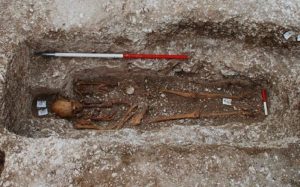
British archaeologists have found, at a UK burial site, the skeleton of a young man who had died of leprosy. According to researchers, this man was not treated as an outcast but was given a traditional pilgrim burial. The new finding challenges modern misconceptions that during medieval period, leprosy was linked to sinfulness and people suffering from it were treated as outcast.
In 11th century, the site of St. Mary Magdalen in Winchester was a leprosarium, founded to treat people suffering from leprosy. The hospital was established a few years after the Norman Conquest in 1066 AD. According to researchers, about 86% of the skeletons found at this site were found to have leprosy lesions.
Archeologists found several skeletons at this site, including one skeleton from grave SK27 that belonged to a young man, who did of leprosy. This man was buried in an extended, supine position. This skeleton was discovered with a pierced scallop shell—a symbol indicating that the person had made the journey to the shrine of St. James in Santiago de Compostela, Spain. The shell was found near his left hand and was pierced with two holes. Santiago de Compostela, along with Rome and Jerusalem, was one of the three great pilgrimage sites of the Medieval period. However, Santiago was the only place where scallop shell souvenirs were distributed to pilgrims.
Researchers genotyped the strain of leprosy found in this skeleton of this pilgrim to learn more about the genetic history of the disease. Lead researcher Simon Roffey, a lecturer in archaeology the University of Winchester in the United Kingdom, and his colleagues also examined the skeleton of the pilgrim to find that this man was between 18 and 25 years old. His bones dated to 1020-1162 AD. He was not a native of Winchester, and probably travelled to this place as he wanted to die there. This was time when religious pilgrimages were at their height in Europe. The leprosy lesions on his skeleton were mostly confined to leg bones. It is likely that he suffered from multiple tumors in his tissues as well as facial paralysis due to nerve damage. Sk27’s dietary isotopes reveled that he consumed a large amount of protein, likely from seafood,
Most of the skeletons excavated at the cemetery at St. Mary Magdalen were found to have genetic strain 31 of leprosy. However, that particular pilgrim‘s skeleton was found to have strain from the 2F lineage (mostly found today in people from south-central and western Asia).
“This would suggest that the individual was quite widely traveled and came into contact with a diverse range of ethnic groups,” Roffey told Live Science.
The presence of leprosy strain types, 31 and 2F, in St. Mary Magdalen cemetery may also suggest that leprosy was introduced at multiple times into southern Britain by the movement of settlers and pilgrims.
“The wider implication of our research, ultimately, is that it can help challenge long-held and false notions of leprosy sufferers being traditionally outcast,” Roffey said.
The detailed findings of the study have been published in the journal PLOS Neglected Tropical Diseases.

